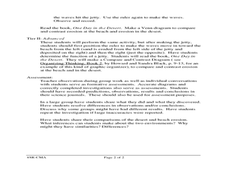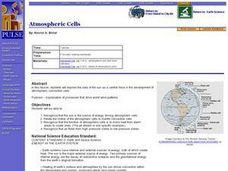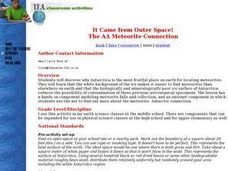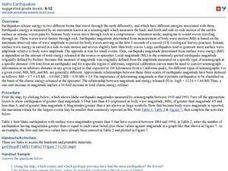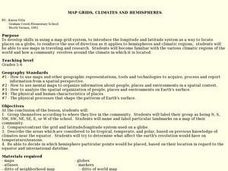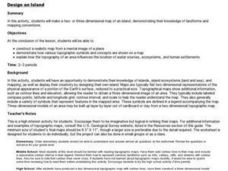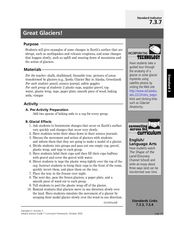Curated OER
Cultures of the Ring of Fire
Students explore the Ring of Fire. In this Ring of Fire lesson, students research information about the Ring of Fire and plate tectonics. Students write 2-page research papers regarding their findings.
Curated OER
Ara of Circles
Pupils identify the differentiate the different properties of circles and parallelograms. In this geometry lesson, students calculate the area of each solid and identify the formula. They relate Pi to the circumference of a circle.
Curated OER
The Physical Environment
Fourth graders use damp sand, a baking pan, and water to simulate erosion. In this erosion lesson plan, 4th graders participate in a simulation to show what moving water does to land.
Curated OER
The Mesoamerican Mystique
Students gain a better understanding of the cultural diversity in the northern region of Central America. They engage in a lesson which focuses on research, archaeology, historical videos, and travel highlights.
Curated OER
Bouncing Balls
Middle schoolers work together to examine how different types of balls react to colliding with different surfaces. They discover the difference between elastic and inelastic collisions. They practice calculating momentum as well.
Curated OER
Atmospheric Cells
Learners recognize that the sun is the source of energy driving atmosphere cells. They relate the motion of the atmospheric cells to mantle convection cells. Students recognize that the function of atmospheric cells is to move heat from...
Curated OER
It Came from Outer Space! The AA Meteorite Connection
Young scholars discover why Antarctica is the most fruitful place on earth for locating meteorites. They work in groups. Students are given a Museum or University Name for each group. They are explained that each group is allowed to...
Curated OER
Idaho Earthquakes
Students examine the types of earthquakes that occur in Idaho. In groups, they compare and contrast the types of energy released and how they affect the movement of the Earth. To end the lesson, they analyze a map showing the magnitudes...
Curated OER
Colored Shadows
Young scholars examine how humans perceive color. In this refracted light activity, students explore the different ways color is seen by the human eye. Young scholars will use colored lights and colored paper and solid objects to make...
Curated OER
How Volcanoes Grow
Learners study volcanoes including rock fragments, ash, aerosols and gases. In this volcano instructional activity students divide into groups and build models of the three major types of volcanoes.
Curated OER
Critical Analysis Leads to Global Action
Learners discover the interconnectedness of the world. In this global studies lesson, students identify challenges the world faces and craft solutions to the problems they identified. Learners present their findings in a PowerPoint...
Curated OER
Attic Red-Figure Kylix
Learners analyze floral and geometric design. In this art design lesson, students create a circular design art using floral, geometric, or anatomical designs. Learners critique their designs as a group and read the background information...
Curated OER
MAP GRIDS, CLIMATES AND HEMISPHERES
Students compare/contrast the grid and latitude/longitude system used on a globe. They describe the areas which are considered to be a tropical, temperate, and polar, based on knowledge of climates.
Curated OER
The Ozone Between Us
Students investigate how ground level ozone occurs in many areas of the country. They study the ozone problems that are associated with population centers.
Curated OER
Salt Water Wedge
Students conduct an experiment to observe the properties of both salt and freshwater. They explain why freshwater will stay at the surface while salt water will travel up a river bottom because of density. Students also research the...
Curated OER
Mapping your watershed
Learners investigate the importance of watersheds around the world. By visiting resource links, students can locate watersheds and their sources in the USA and Russia and analyze their effects on the surrounding topography. This lesson...
Curated OER
Debris Dilemmas
Students examine debris, what it is, where it comes from and where they go. In this debris lesson students view a video, answer questions and discuss what they learned.
Curated OER
So, What's it Doing Today?
Students describe short-term variations in oceanographic parameters in the Gulf Stream. In this ocean habitats lesson students use satellite imagery to obtain information in the Gulf Stream.
Curated OER
Spongy Wetlands
Students sort things that absorb and things that do not absorb, They predict, orally or in writing, what happens to houses with or without wetlands. Students build a wetland area in a meat tray to show how wetlands absorb water, and they...
Curated OER
Design an Island
Students make a map of an imaginary island using the topographic symbols provided from a worksheet. Students place lakes, dwellins, reefs, etc. in areas where they would logically be located from understanding how the topography of an...
Curated OER
Introduction to Earth Sun Relationships Incorporating P.E.
Third graders investigate space science by performing physical activities. In this solar system lesson, 3rd graders perform a relay activitiy with their class in which they race between different "planets". Students define space...
Curated OER
Great Glaciers!
Seventh graders study the earths surface and how changes happen to it. In this glacier lesson students complete a lab activity to see how glaciers form.
Curated OER
Mud Splat Craters
Students simulate crater formation using mud. In this earth science lesson, students identify the features of a crater. They explain how the force of impact affect the crater's appearance.
Curated OER
The Path of Pollution
Students examine the path of pollution that was created by the Chernobyl accident. They discover how air pollution travels from one area to another and sequentially locate the countries where radiation traveled to.




